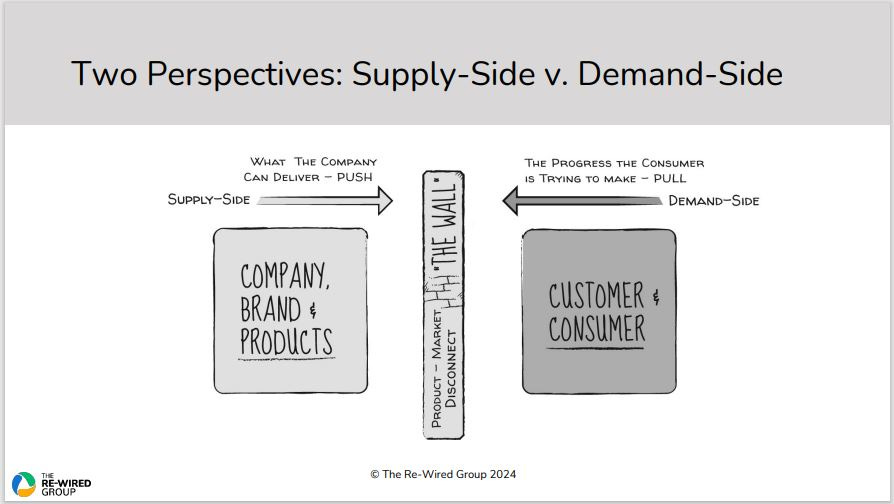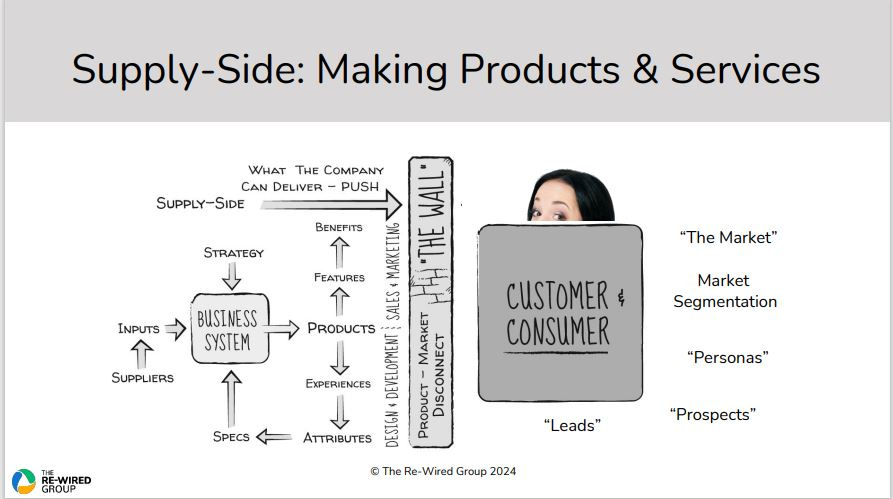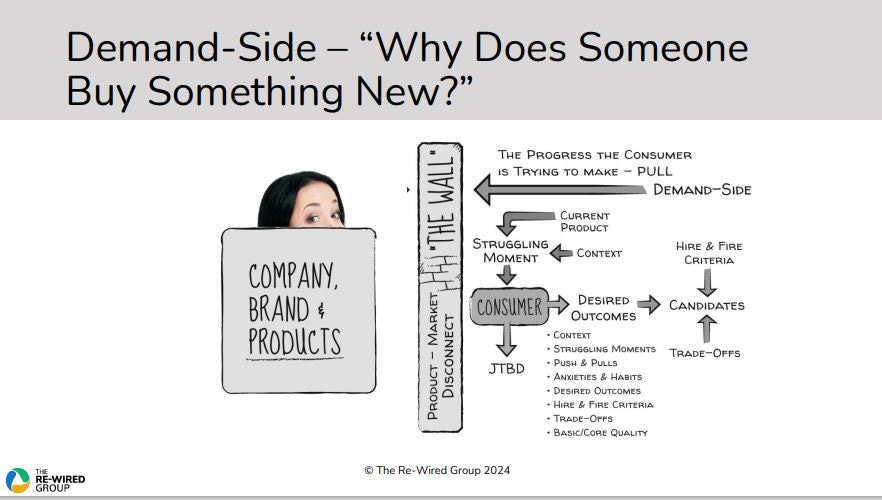Supply Side Sales vs. Demand Side Sales
Want to know how to grow your sales and lift those conversion metrics? Flip the script and start looking at it from the customer lens!
In a recent Product Circle Chat with Bob Moesta, we were introduced to two approaches to Sales - Supply Side Sales and Demand Side Sales.
It left a lasting impression on me because traditional (supply side) sales never sat well with me. Maybe it’s a product management thing. We’re obsessed with solving problems and creating value for customers that create value for companies. A customer first approach (tell me if I’m wrong).
Anyway, these two approaches offer distinct paths for reaching customers and delivering products or services effectively. While Supply Side Sales sounded internally focussed, Demand Side Sales was clearly aligned to the Customer and their Struggling Moments.
You can watch Bob talk about this in our recent Product Circle Chat or visit him at Rewired.
The Origins of Demand Side Sales
Demand side sales is a concept deeply rooted in understanding customer jobs. The idea emerged from the "Jobs to be Done" framework, popularised by renowned business thinker Clayton Christensen and expanded upon by Bob Moesta. This approach is centred on the notion that customers “hire” products or services to do a specific job. By focusing on what customers are trying to achieve—their jobs—companies can create solutions that fit seamlessly into their lives. Demand side sales flips traditional sales methods on their head, starting with the customer's needs and working backward to develop the product.
The Traditional Approach: Supply Side Sales
Imagine a company that has just developed an innovative new gadget. The supply side approach, also known as product-centric sales, focuses on showcasing the gadget's impressive features, sleek design, and cutting-edge technology. The marketing team crafts a compelling message about how this product is the best on the market, highlighting every detail that sets it apart from competitors.
In supply side sales, the emphasis is on the product itself. The company believes that by pushing this message out through various channels, customers will be convinced of the product's superiority and feel compelled to buy it. This approach encourages continuous product innovation and can help build a strong brand identity based on product excellence.
However, there's a downside. The market is flooded with innovative products, and standing out solely based on features can be challenging. Ignoring benefits, problems customers need solved (or Jobs they hire products for) there's a risk that the product will not convert. It may not align with actual customer needs, leading to lower adoption rates. It's a bit like shouting into the void, hoping someone will listen.
The Customer-Centric Approach: Demand Side Sales
Now, let’s flip the script. Instead of starting with the product, imagine starting with the customer. Demand side sales, or customer-centric sales, focus on understanding and solving the customer's problems or needs. This approach is about empathy and connection, prioritising the customer's context and desired outcomes.
Consider the case of Casper, the mattress company. Traditional market analysis didn’t suggest a need for another mattress company. But Casper approached the market differently. They didn't just create a mattress; they studied what made buying a mattress so painful. People hated the overwhelming choices, the awkward in-store experiences, and the uncertainty about whether they were making the right decision.
By understanding these pain points, Casper developed a solution that simplified the buying process. They offered a limited range of high-quality mattresses, sold online, delivered in a compact box, with a risk-free trial period. This approach resonated with customers, addressing their specific struggles and making the purchase decision easy and stress-free. In just four and a half years, Casper went from zero to a billion-dollar company.
Transitioning from Supply Side to Demand Side Sales
Transitioning from a supply side approach to a demand side approach involves a fundamental shift in mindset and operations. It involves:
1. Customer Research and Understanding
Case Study - Intercom: When Intercom first launched, it marketed itself as an all-in-one customer communication tool. However, after extensive customer interviews, they discovered distinct jobs their product was hired to do, such as acquiring new customers, engaging existing ones, and providing customer support. By focusing on these specific jobs, they tailored their product offerings and marketing strategies, leading to significant growth.
2. Empathy Mapping and Customer Journeys
Develop detailed empathy maps and customer journey maps to understand the emotional and functional jobs customers need to be done. Identify pain points and opportunities for improvement.
3. Product and Service Alignment
Case Study - Snickers: Initially, Snickers focused on being a delicious candy bar. However, research revealed that many people ate Snickers to satisfy hunger between meals. By repositioning Snickers as a hunger-satisfying snack, their marketing strategy changed, leading to the famous “You’re not you when you’re hungry” campaign, which significantly boosted sales.
4. Continuous Discovery with Feedback Loops
Implementing a continuous discovery and delivery approach with agile processes allows your team to rapidly iterate on products based on customer feedback. Regularly update and refine products to better meet customer needs.
5. Holistic Marketing and Sales Strategy
Shift marketing and sales strategies to highlight how the product solves specific customer problems rather than just showcasing features. Use customer testimonials and case studies to build trust and credibility.
Case Study: Slack: Slack was initially marketed as a team communication tool. By focusing on specific pain points like reducing email clutter and improving team collaboration, Slack created targeted marketing campaigns that spoke directly to these issues. This customer-centric approach helped them become a dominant player in the market.
6. Employee Training and Culture Shift
Train employees across all departments to adopt a customer-centric mindset. Encourage empathy and deep understanding of customer needs in every interaction. Consider undertaking Jobs to Be Done Customer Discovery Interviews with the Wheel of Progress Canvas.
Case Study: Apple: Apple's employees are trained to understand and solve customer problems, not just sell products. This approach has helped Apple create a loyal customer base that sees Apple products as essential tools for their daily lives.
Why Shift to Demand Side Sales?
The success of Casper highlights why shifting to demand side sales can be so effective. Here are a few reasons:
Better Market Fit: By focusing on the customer's actual needs, products are better tailored to the market, increasing the chances of success.
Enhanced Customer Satisfaction: Products designed to solve specific problems lead to higher customer satisfaction and loyalty, fostering long-term relationships.
Reduced Waste: Understanding what customers truly need helps avoid unnecessary features, reducing waste in product development.
Competitive Advantage: Competing on solving problems rather than just features creates a unique market position, setting the company apart from competitors.
Sustainable Growth: Focusing on customer needs drives sustainable growth, adapting to changing market conditions and evolving customer preferences.
While the supply side sales approach fixates on product features, demand side sales prioritise understanding and resolving customer problems. In a highly complex environment, understanding a customer’s context and the job they’re hiring for is not only important when developing products, but also in how to message, market and sell to customers in a way that meets their hiring criteria.
Flip your sales process on its head: instead of asking, “How can we sell this product?” start asking, “How can we help our customers in their struggling moment with this product?”
This simple shift in perspective can make all the difference in building a successful, customer-centric business.
Want to move to Demand Side Sales?
Ready to flip the script and start meeting customers where they are? I can help. Drop me an email at irene@phronesisadvisory.com
Are you new to Product Management and want to learn from me?
I created a Course. For people new to Product Management.
Aligned it with the Learning Outcomes created by Product greats like Jeff Patton and others. Had it certified by the globally recognised ICAgile.
Choose to spend 2 days learning from me - either face to face or via Zoom - with ICAgile Certified Professional in Product Management (ICP-PDM).
And if you’re looking for a sneaky discount, send me an email at irene@phronesisadvisory.com






